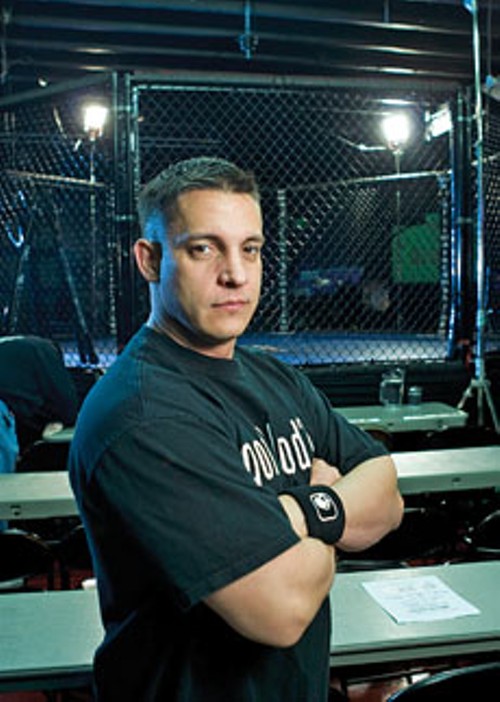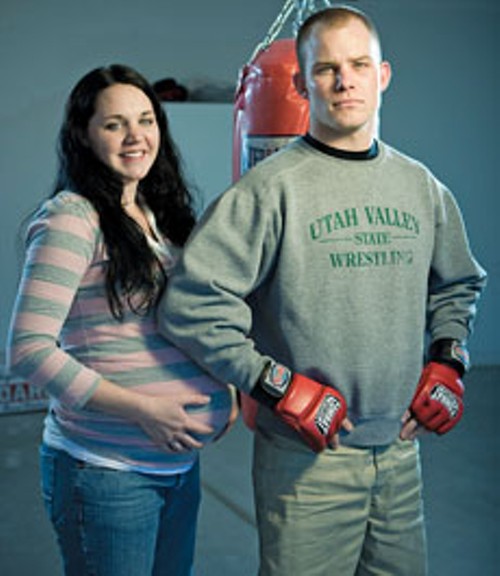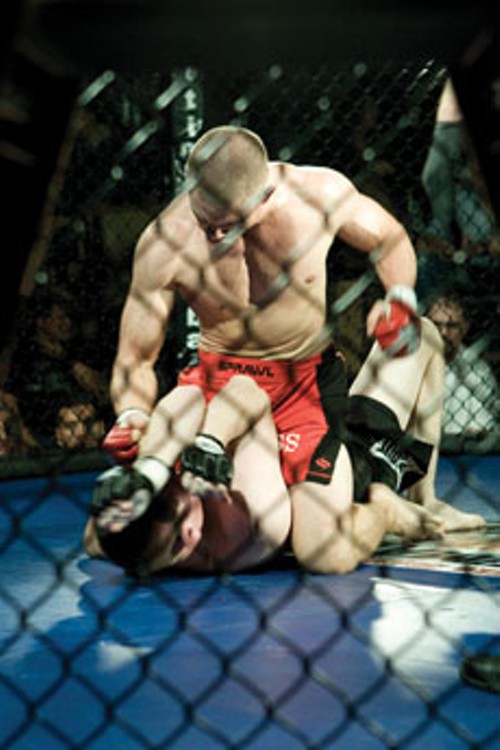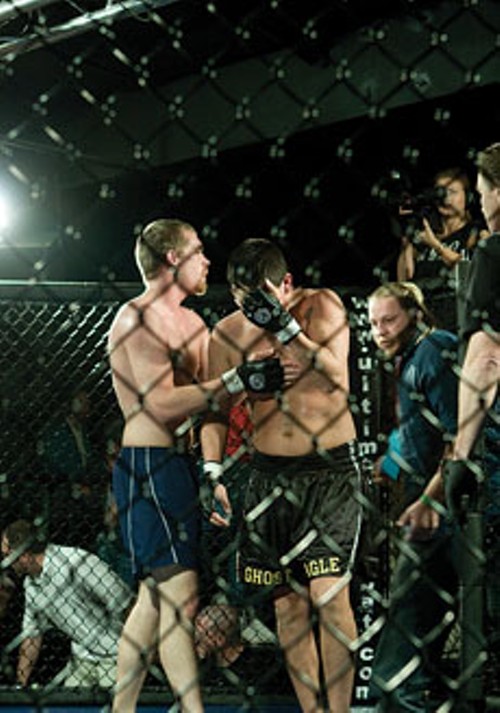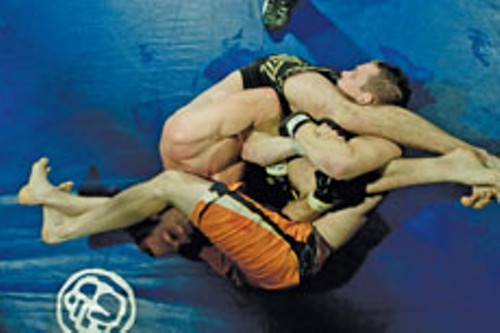In a typical Saturday night in downtown Salt Lake City, Robert Sandstrom makes his way into a huge room at Bliss nightclub. Rap music playing at ear ear-splitting decibels serves as the backdrop while Sandstrom walks behind a man wearing a T-shirt that reads, “Fighting Solves Everything.” He pushes his way through a crowd of hundreds of people who have paid $35 to get in—more than that if you add drinks to the bill.
Settled on his destination at last, Sandstrom climbs into a platform surrounded on all sides by a chain-link fence. A scantily clad woman, better known as a “ring girl,” and an iron-voiced announcer exit. A gate shuts behind them. Sandstrom is now on his own, a man in a cage.
This is his moment to shine in the world of Mixed Martial Arts—or MMA. The fighting he is about to take part in allows everything from stand-up boxing to on-the-mat wrestling and any form of martial arts in between. Only a few potentially injurious moves are barred at all.
At one point in the bout, Sandstrom flips his opponent on his chest, then sits on the guy’s chest while pounding his face with only minimally padded hands. It looks like a fight between two fifth-graders in the schoolyard and draws enough blood to end up smeared on Sandstrom’s chest and face. Minutes later, Sandstrom gets the other fighter in a chokehold, effectively cutting off his air supply. Just short of passing out, the opponent taps furiously on the canvas floor, signaling the referee to stop the fight.
The crowd erupts.
Immediately after leaving the cage, Sandstrom collects $150 in prize money along with a certificate good for a free steak dinner. He passes a required post-fight checkup by an onsite doctor. Then he calls it a night.
Not bad for somebody who started training in his backyard with his dad just weeks before signing up for his first fight.
Sandstrom is a former college baseball player who was rehabbing a shoulder injury while awaiting a professional baseball tryout. During rehab, he saw a TV broadcast of the Ultimate Fighting Championship (UFC)—the highest level of MMA—and decided to give the sport a try. When he thought he was ready, Sandstrom took documentation of the negative results of an HIV test and $27 to register with the state athletic commission, and signed up for a fight with a local promoter.
Sandstrom had never been in a fight before—organized or otherwise—and didn’t feel he had ever done anything particularly brutal.
“I don’t have anything against the other guy. I don’t even know him,” he says. “People need to realize it’s a sport, not a fight. It’s about skill, not wanting to hurt someone.”
It may be about skill and sport. Or it may be a statement on America’s fascination with violence passing as entertainment. One thing is sure: Mixed Martial Arts is enjoying a burst of popularity in Utah. The fights involve a sizeable number of otherwise staid men, many of them breadwinning Mormon husbands and fathers, who wouldn’t normally be caught dead in a nightclub.
Local MMA promoter Mike Stidham says he has so many LDS fighters signing up he has to be careful not to schedule too many of them for his cards at clubs. That’s because friends and family who come to watch the fighters won’t buy enough liquor to keep the club owners happy.
“I think there’s a lot of pent-up frustration in LDS culture,” Stidham says. “A lot of guys have a lot of anger.”
Captain Moroni Leads the Way
While members of The Church of Jesus Christ of Latter-day Saints worship the man who counseled, “Love your enemies” and “turn the other cheek,” one of the heroes of the Book of Mormon is Captain Moroni, who wrote to an opponent: “I will arm my women and my children, and I will come against you … and it shall be blood for blood, yea, life for life; and I will give you battle even until you are destroyed from off the face of the earth.” (Alma 54:12)
In these latter days, as the LDS Church became fully engaged in sending missionaries worldwide to preach a message of peace, West Jordan boxer Gene Fullmer became a full-fledged Mormon celebrity after defeating Sugar Ray Robinson to win the world middleweight title in 1957. “Fight clubs” only began springing up throughout Utah County in the late 1990s. Today, 60,000 or so of the faithful gather in Provo at BYU’s LaVell Edwards’ Stadium on Saturdays every fall to watch men in armor run into each other at high speed.
This history of violence among the LDS faithful might help explain MMA’s surprising success locally.
The U.S. Army is a prominent sponsor of local MMA events—a banner listing the address of the recruiting station is prominently displayed at Salt Lake City fights. Army Captain Chris McGrail says he has been stationed in a variety of places around the country but has yet to see the passion for MMA that he’s found in Utah.
“I was surprised to see it be such a big sport in Utah,” he says while attending a recent fight card, “because Utah’s known for being pretty conservative in other areas.”
Stidham, who also runs the Ultimate Combat Training Center, can draw crowds in the thousands (about 30 percent of them women) when he holds quarterly championship events at venues such as the E Center or EnergySolutions Arena. He also puts on weekly Saturday night fight cards at a downtown club where, for some LDS fighters, the sinful atmosphere is of greater concern than the possibility of getting beaten to a pulp.
Such was the case for Gerrit Greer when he appeared on a recent fight card. A carpenter from Provo and devout member of the LDS Church, Greer stood out because he didn’t have any tattoos, and because his wife Gwendolyn, then seven months pregnant with the couple’s third child, was acting as his corner person between rounds.
“I was mostly worried about her being in that crowd, not having someone with her,” Greer says, sporting a golf-ball sized bruise on his brow from his first fight.
A former wrestler at Utah Valley State College, Greer says he had been training and wanted to have a goal to shoot for—goal-setting being something members of the LDS Church are strongly encouraged to do. He and Gwendolyn enjoy watching UFC fighting on TV, and she says she was only “slightly concerned” when he told her he wanted to fight. She even brags about him to her friends in nursing school. However, the bragging now stops at the chapel doors on Sunday.
“When you say ‘cage fight,’ there’s a stigma attached. You certainly get raised eyebrows,” Gerrit says. Still, he points out, “A lot of LDS kids have a lot of aggression they need an outlet for,” and fighting in a controlled and regulated environment might be a more constructive way to deal with that aggression than sex, drugs and rock & roll.
No Eye Gouging, Please
MMA has come a long way since the 1990s, when Arizona Senator and Republican Presidential candidate John McCain called MMA “human cockfighting” and led a campaign that resulted in MMA fights being removed from cable airwaves and banned in 36 states.
MMA had come to America in the early 1990s with the claim that it would allow the various martial-arts disciplines to prove theirs was the best system of self-defense in a no-holds barred fight. The new form of fighting was seen as more spectacle than sport, partially because there were only two rules—no eye gouging and no fish-hooking—and anything else was allowed. That led to McCain’s charge, and the sport appeared to be washed up heading into the 21st century.
But, in 2001, an investor group purchased UFC and placed former fighter Dana White in charge of the business. Rules were added to protect fighters (no head butting, hair pulling, kneeing the head of a downed opponent, putting a finger into an orifice or laceration of an opponent, etc.) and White began aggressively promoting the sport on TV with spectacular success. In May 2007, Sports Illustrated reported UFC’s reality show Ultimate Fighter regularly draws better than the NBA or Major League Baseball among the highly coveted demographic of males age 18-34. In 2006, UFC’s pay-per-view events made more money than the pay-per-view events for boxing on HBO or WWE wrestling.
Despite reaching that level of commercial appeal, MMA still “gets a bad rap because it’s a sport without a ball,” Stidham says. He recalled listening to an 80-something woman yell “Kill ’em,” while attending last year’s Utah-BYU football game. “If they’re fighting over yardage it’s OK, but once they step into a cage, suddenly it’s bad. There’s never been a death in MMA. The same can’t be said for Little League baseball.”
Proponents of MMA argue that injuries from their sport aren’t as bad as they seem when viewed from a long-term perspective. The cuts and bruises on the faces and bodies of MMA fighters can be seen immediately but will heal; the repeated blows to the head and body suffered by boxers and football players can’t be seen right away but take a serious toll later. An MMA fighter might look bad when he walks out of the cage, but is in happier shape than a 50-year-old former boxer who can’t remember anything or a middle-age running back who can’t walk after his playing days are over.
For some fighters, MMA is a safe and controlled outlet for aggression.
“I like to beat up other girls,” says Andrea Miller, a female MMA fighter. “When I do it this way, I make money and don’t get in trouble. I can take out my anger without getting the law involved.”
Some argue that MMA represents the next step in contact sports, because it is fighting’s ultimate free market.
“It’s the evolution of fighting,” Alexander Scott says recently while watching fights in downtown Salt Lake City. He has trained in the martial arts and looks forward to trying his first fight in 2008. “There’s so much that goes into it. It’s vicious but, at the same time, it’s a science.”
Many fighters stress MMA is not so much about hurting somebody else, but training in order to be able execute a game plan or react to what’s needed in a split second—as in baseball or basketball.
“Being a tough sonofabitch certainly doesn’t hurt, that’s for sure,” fighter Salvador Sanchez explains. “But it only gets you so far. The higher up you get the more it becomes like chess-match moves. You aren’t thinking about hurting the other guy but about what moves you need to make to counter his moves. If you have two trained fighters, it’s really quite beautiful. It becomes an art form.”
It’s Almost Like Being in Rome
Art form or pure sport, MMA is governed by the Pete Suazo Utah Athletic Commission (PSUAC), a state government agency with which all fighters, promoters and referees must register. PSUAC requires that promoters have a physician (who conducts pre- and post-fight check-ups), EMTs and an ambulance on hand at all fights. PSUAC also sends out several inspectors to events to make sure fighters are taken care of and paid immediately after each match. Promoters pay a fee to PSUAC based on the size of the audience ($200-$500 in most cases), but the agency is largely funded by the state.
The current PSUAC chairman is Alan Dayton, once a member of ex-Salt Lake County Mayor Nancy Workman’s administration and now a powerful legislative lobbyist for companies such as Intermountain Healthcare. He was appointed by Gov. Jon Huntsman Jr. a year ago. At a recent MMA event, he says he came into the job with no prior knowledge of the sport.
“It’s an acquired taste,” Dayton says. “It’s violent but, arguably, not any more violent than football or hockey.”
Dayton’s committee also oversees boxing and is looking at regulating what is known as “white-collar boxing,” a form of fighting that has recently become popular in Utah County where people who simply use boxing as a form of training get together to test their skills against one another in events where no money changes hands.
“We’ve been trying to apply boxing rules to this sport (MMA), and it really doesn’t work,” Dayton says. “We’re working on separating the rules. Each sport needs to have its own unique set of rules.”
The differences between boxing and MMA have been magnified on a national level as the rise of MMA has been blamed in part for a decline in the popularity of boxing. Although one could argue professional boxing had enough of its own internal problems to cause a downfall, some boxing purists view MMA as glorified bar-fighting that can’t hold a candle to “the sweet science.”
In Utah, the sibling sports seem to have a fairly collegial relationship, with both sides recognizing, as PSUAC secretary Bill Colbert says, “it’s in everyone’s interest that both sports do well.”
The mutual respect is strong enough that Stidham and boxing promoter Bill Oleson even try to stay out of each others’ way when scheduling events.
“Let’s face it: [MMA] has caught on big time,” Oleson says. “They’re doing everything right. Everyone has to benefit. I want [Stidham] to do well.”
For his part, Stidham says, “I’m a boxing fan. We did spring from that well. I don’t know if one sport is successful without the other.”
Rick Montoya, president of the Utah chapter of USA Boxing, which runs amateur programs and promotes the sport among youth, says, “MMA was a shot in the arm for contact sports no matter how you look at it.” This is partly because boxing has received more acceptance in “mainstream society” and looks downright civil compared to MMA.
The equanimity between the two sides may also be because both sports seek different audiences.
“At an MMA event, you’ll see a lot of people in their 20s and early 30s who are very energetic and make a lot of noise,” Colbert says. “At a standard boxing event, you’ll see a totally different crowd. Boxing crowds are older, more ethnically diverse and more working-class. Most people I see at MMA events, very few of them would go to a pro-boxing event.”
The boxing community also seems to take the view that, while MMA is certainly here to stay, boxing has already taken the new sport’s best shot and is still standing. “Sooner or later, it isn’t going to be as new,” Montoya says. MMA will eventually reach a plateau where it will have to face many of the same issues boxing has.
“There’s always going to be boxing,” Montoya says. “It’s been around since the Roman days, for crying out loud!”
Some segments of society need an outlet for aggression and a larger segment will want to vicariously blow off steam by watching the first group. As America learned during Prohibition, some people are going to engage in certain activities regardless of their legality, so MMA promoters, fighters and fans argue it’s better simply to go legal and make sure the taboo behavior is well regulated. If people are going to fight anyway, why not do it under controlled conditions and let them earn some money while they’re at it?
EMT Jef Jones, who regularly works at the fights, says, “This is stuff that’s left over from caveman days. It’s just humanity’s outlet for brutality, but for some reason we’re drawn to it.”
MMA is undeniably brutal, but it’s an unvarnished brutality that doesn’t make any excuses for what it is. While many forms of media glorify savagery by not showing its consequences, the results of MMA blows are crystal clear to anyone watching a fight. In a society that can’t seem to get enough glamorized violence, MMA can at least make the argument that it’s honest.
Bash-O-Rama
The Ultimate Combat Experience championships will be held on Saturday, Dec. 1, at EnergySolutions Arena, beginning at 3 p.m. Tickets are $25 and can be purchased through UCombat.com. Utah fighter Jeremy Horn of Elite Performance Gym, who has fought in Ultimate Fighting Championship pay-per-view events against world champions, will appear in the card’s main event.
Weekly Ultimate Combat Experience fights are held Saturday nights at Elevate at The Hotel, 155 W. 200 South. For more information, visit UCombat.com. Taped shows featuring the fights can be seen on Park City Television at 10 a.m. on Saturdays and Sundays or anytime on Comcast On Demand.
More by Geoff Griffin
-
A Family New Year
How to ring in 2020 with revelers of all ages.
- Dec 25, 2019
-
The 12 Arts of Christmas
A delightful dozen options for your holiday entertainment needs.
- Nov 27, 2019
-
Season Kickoff
A look at what's new, or old but great, at Utah's ski and snowboard resorts for the winter season.
- Nov 13, 2019
- More »
Latest in Cover Story
Readers also liked…
-
Forget the family pedigree—Robert F. Kennedy Jr should not be the next president of the United States
Trojan Horse
- Jun 21, 2023
-
Women decry harassment and toxic culture at St. George auto dealership
Men at Work
- Oct 11, 2023



